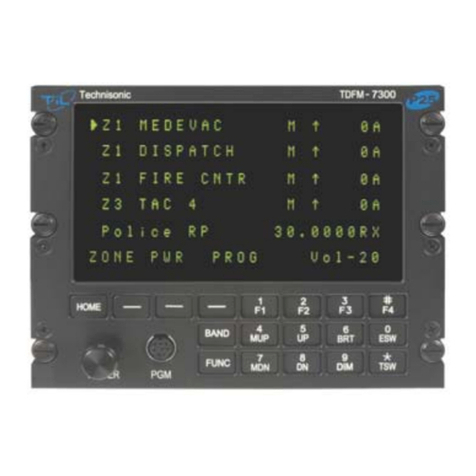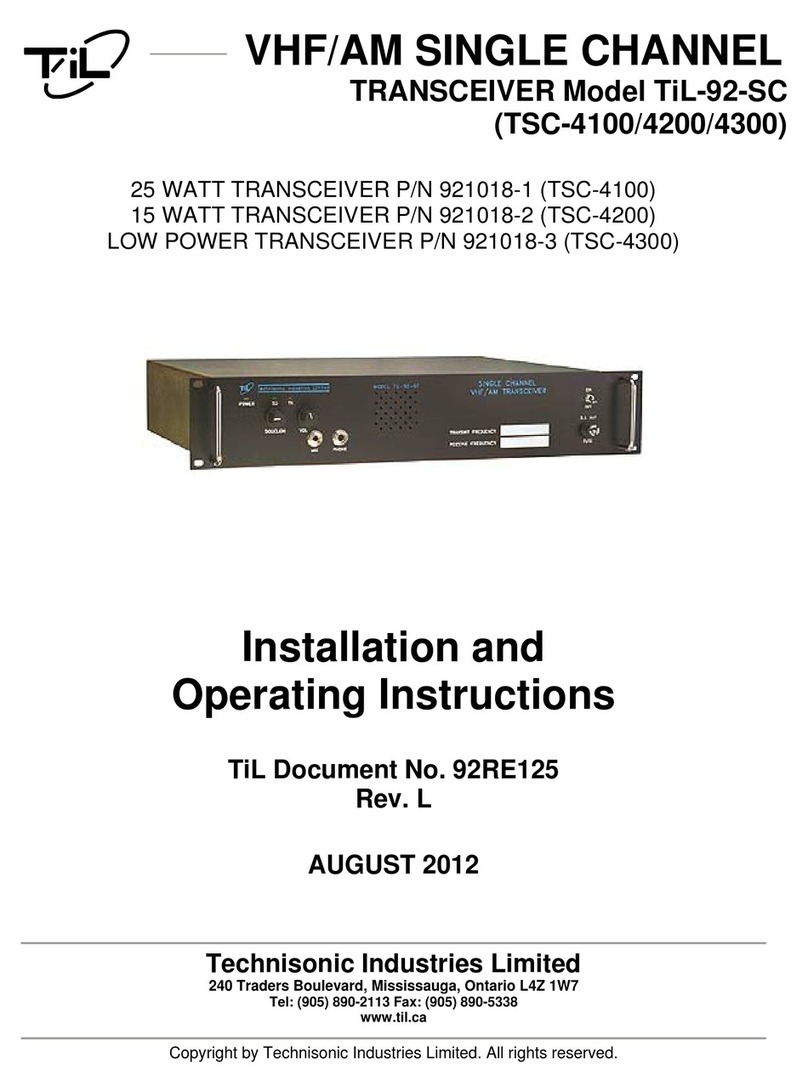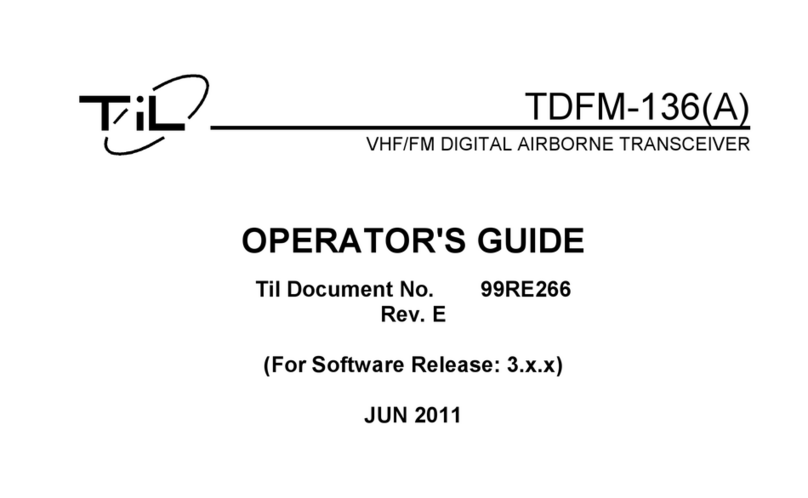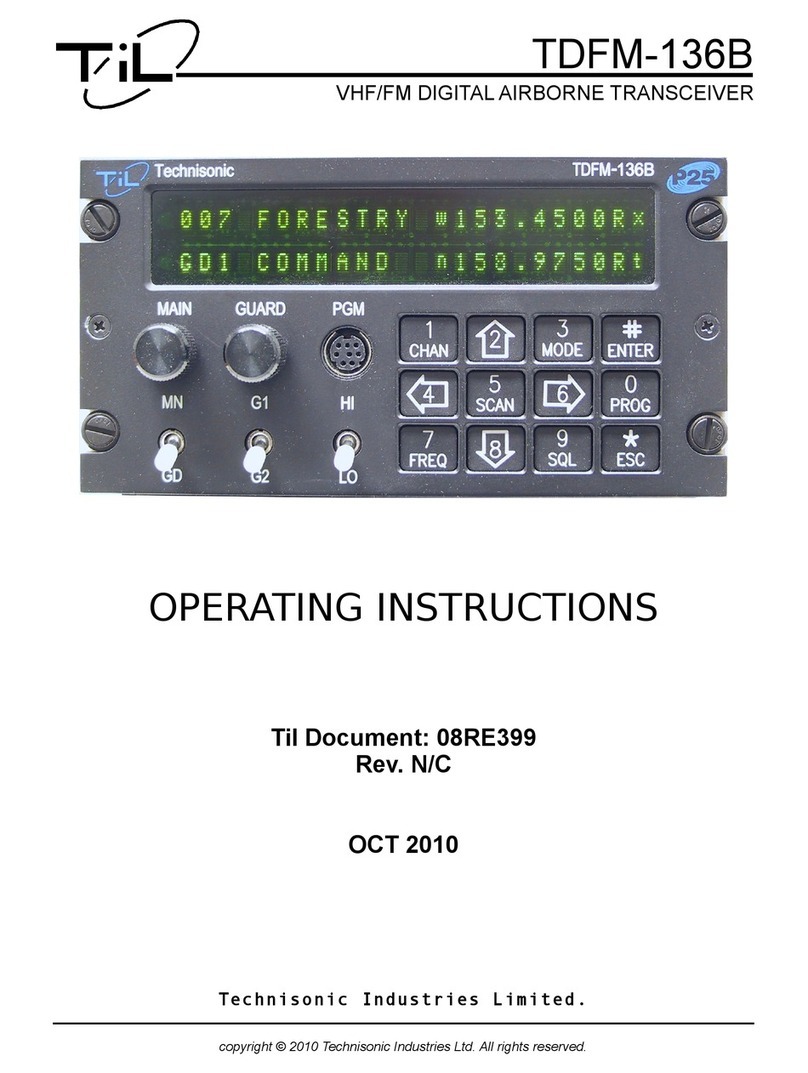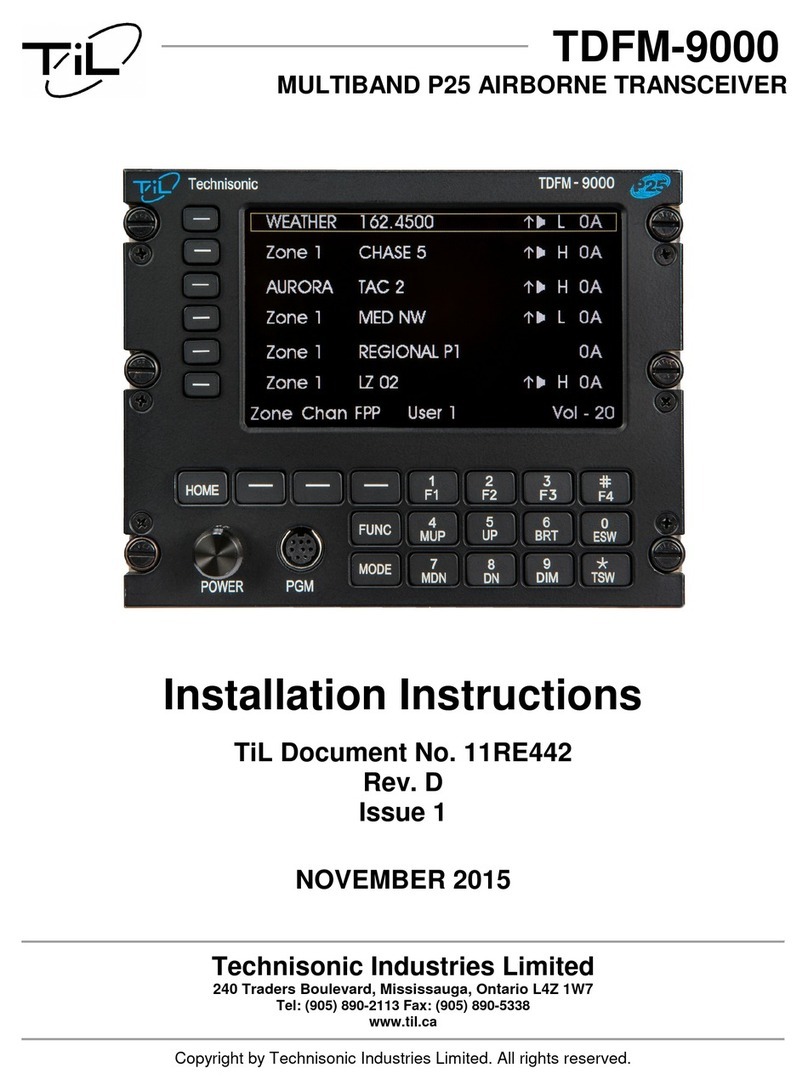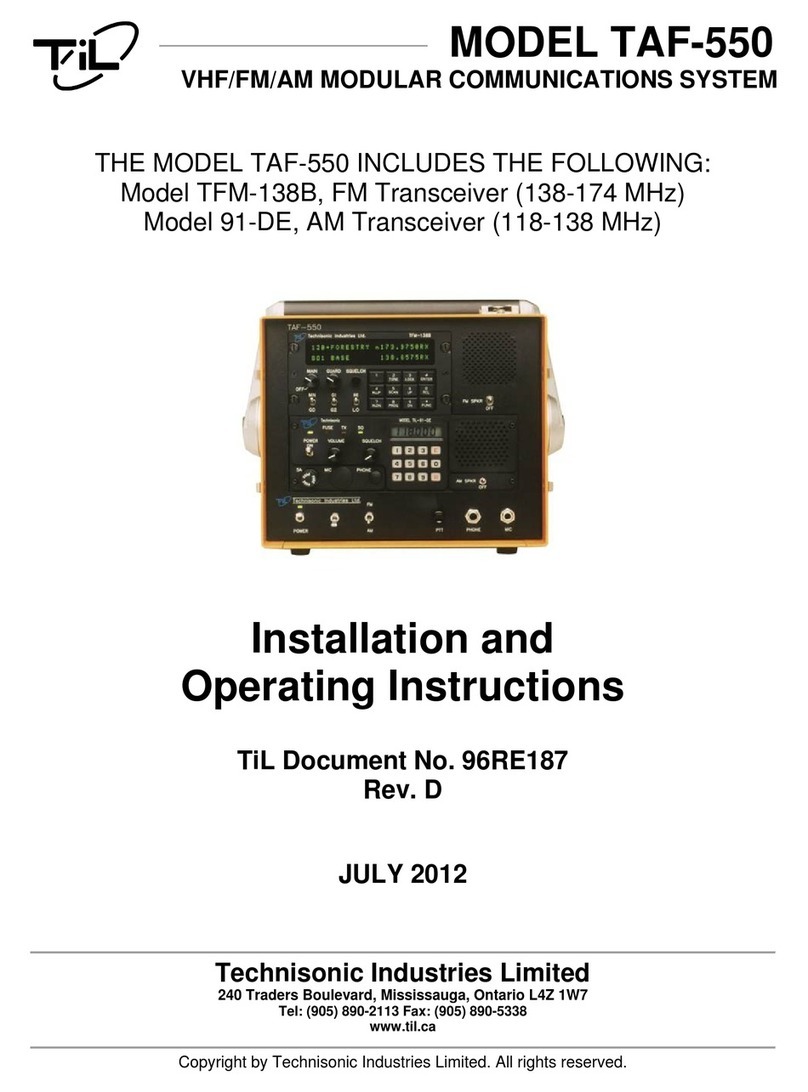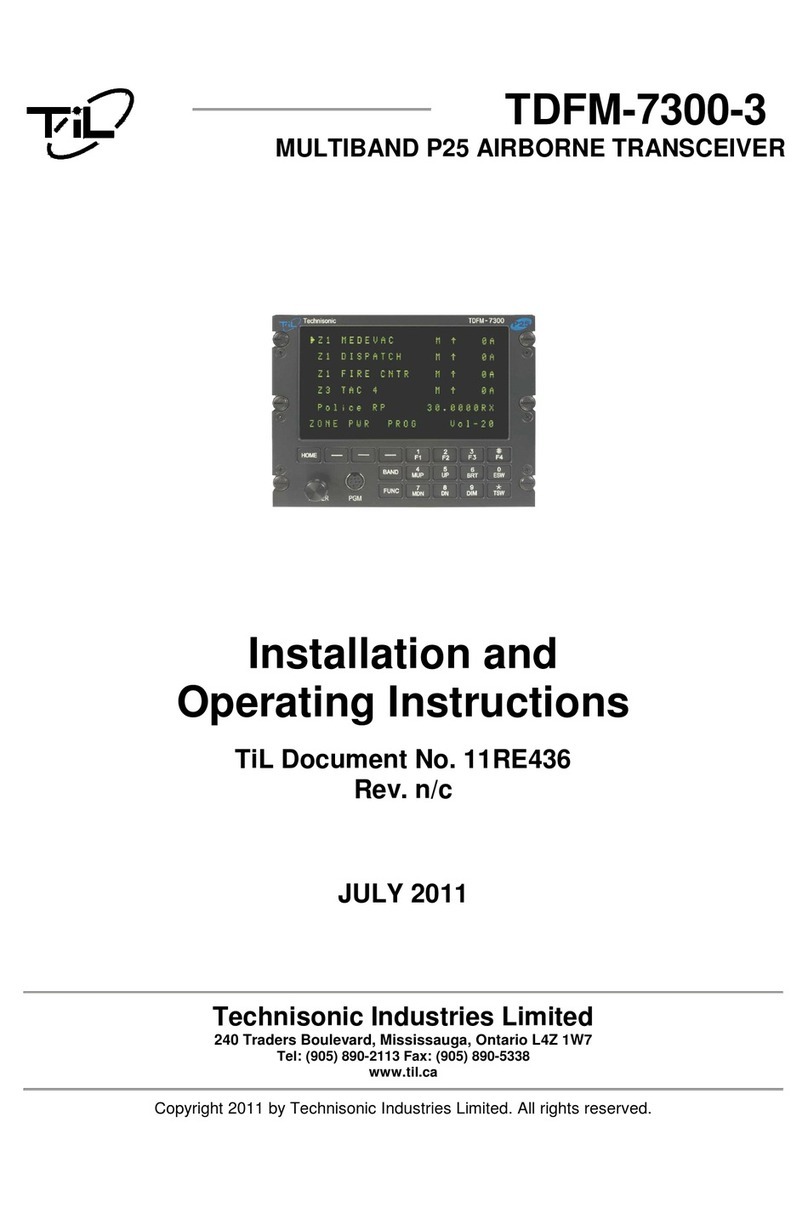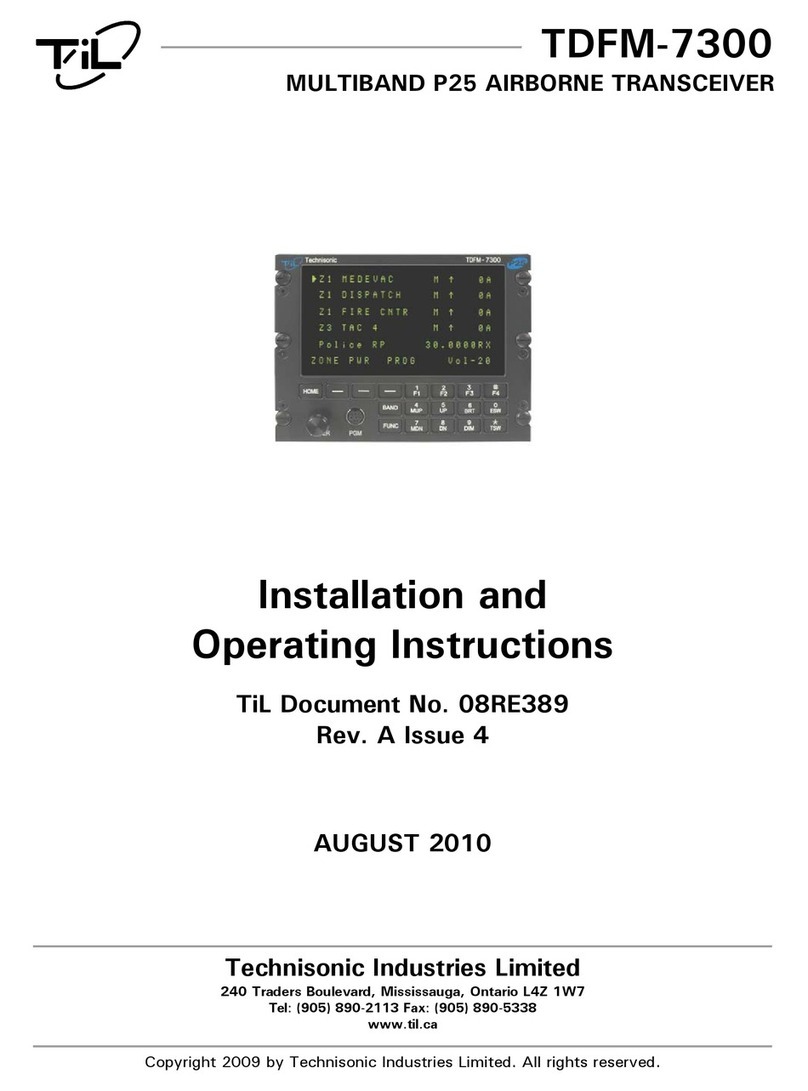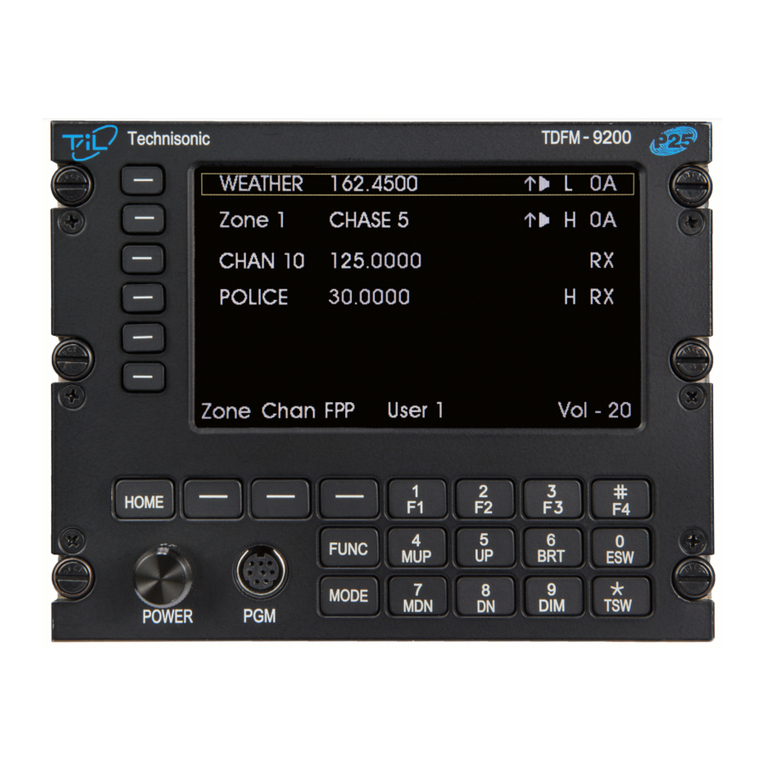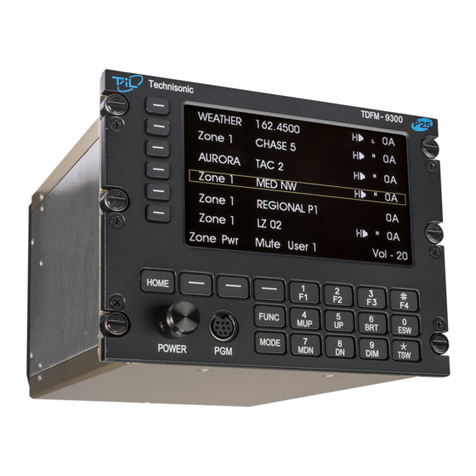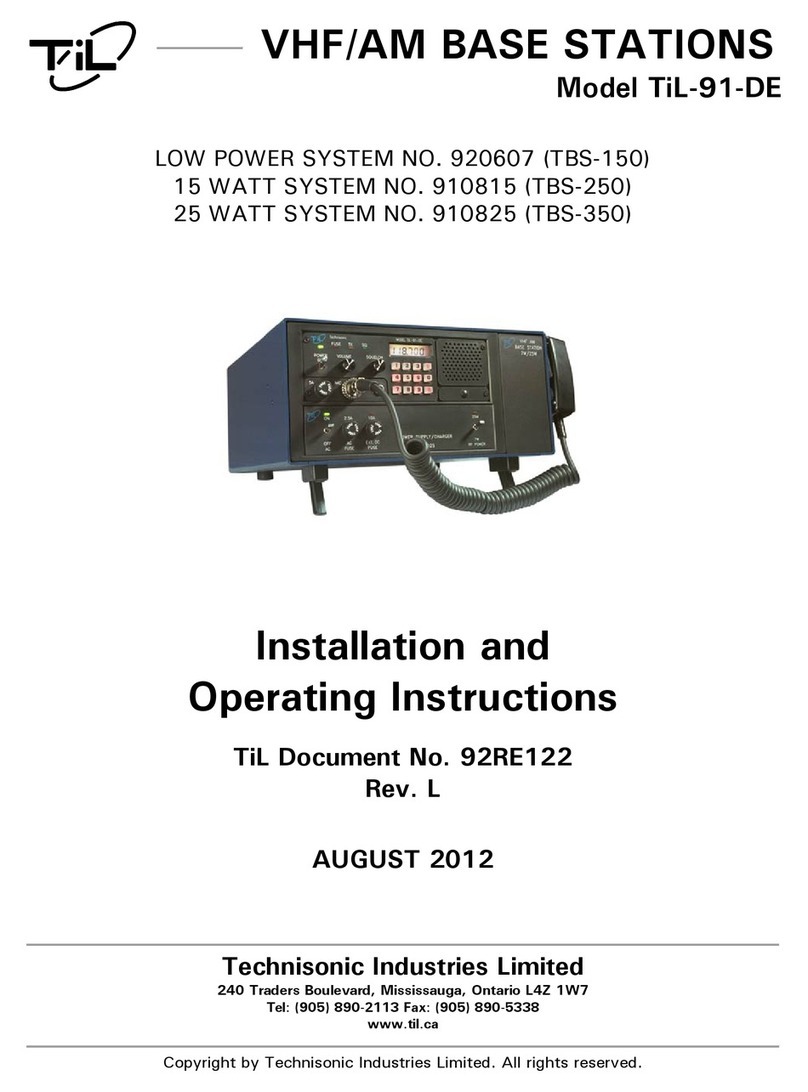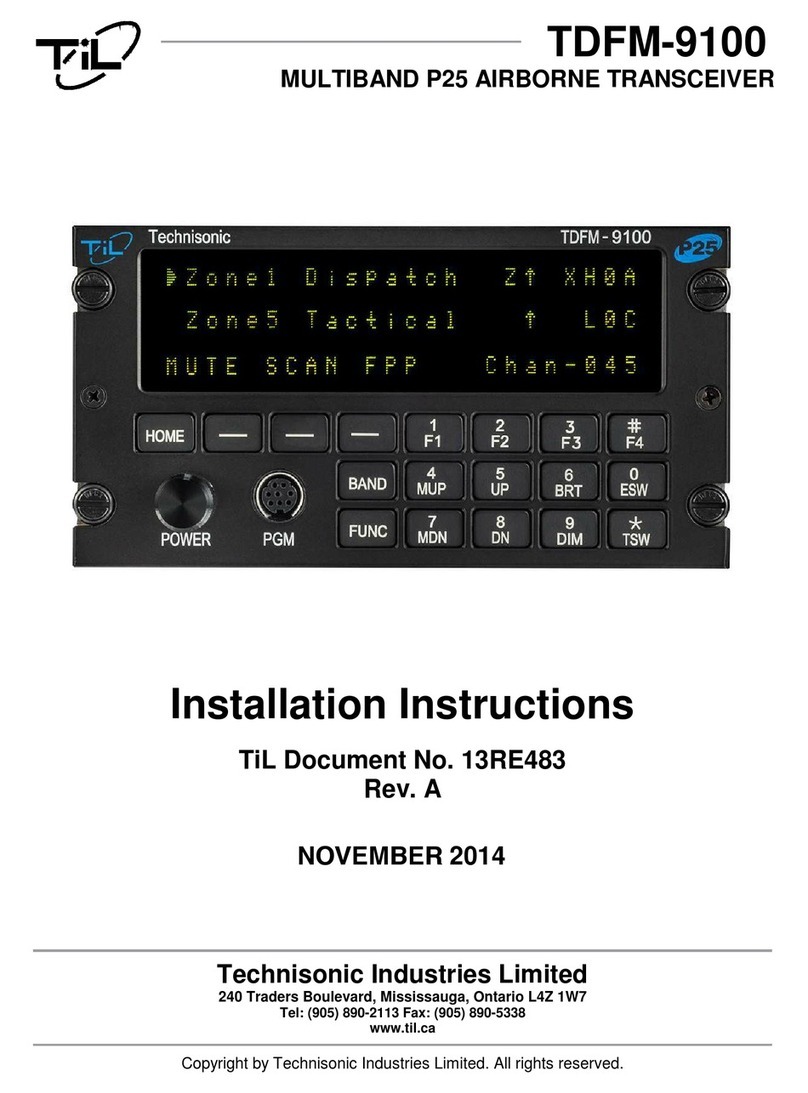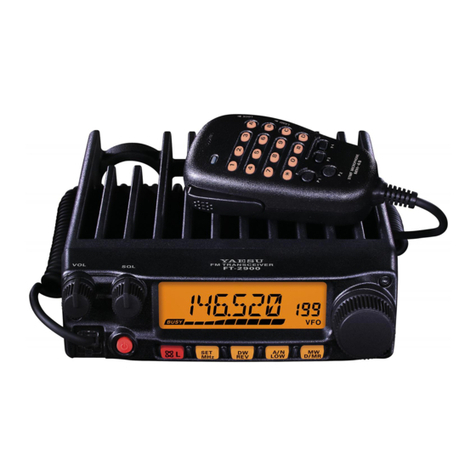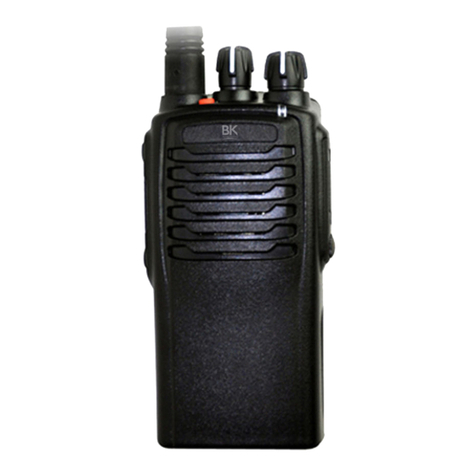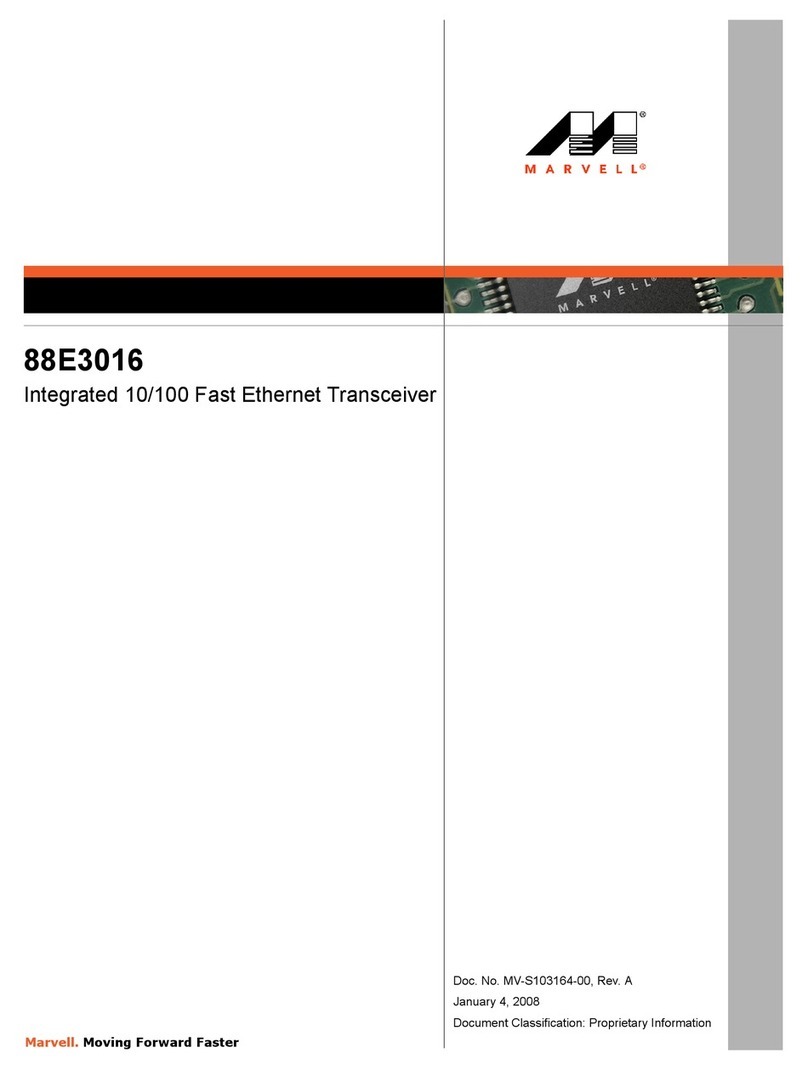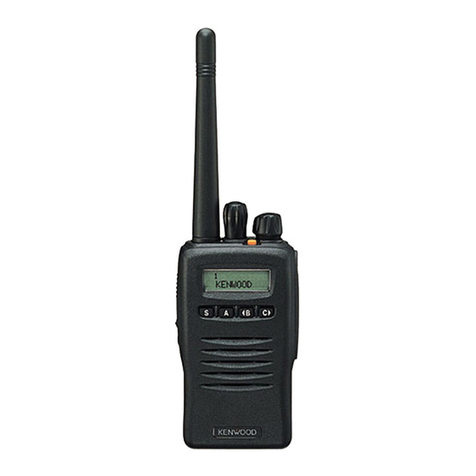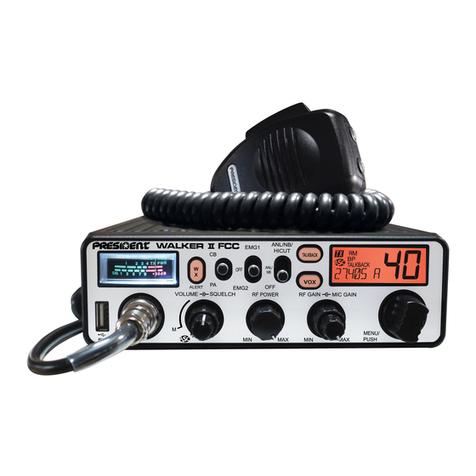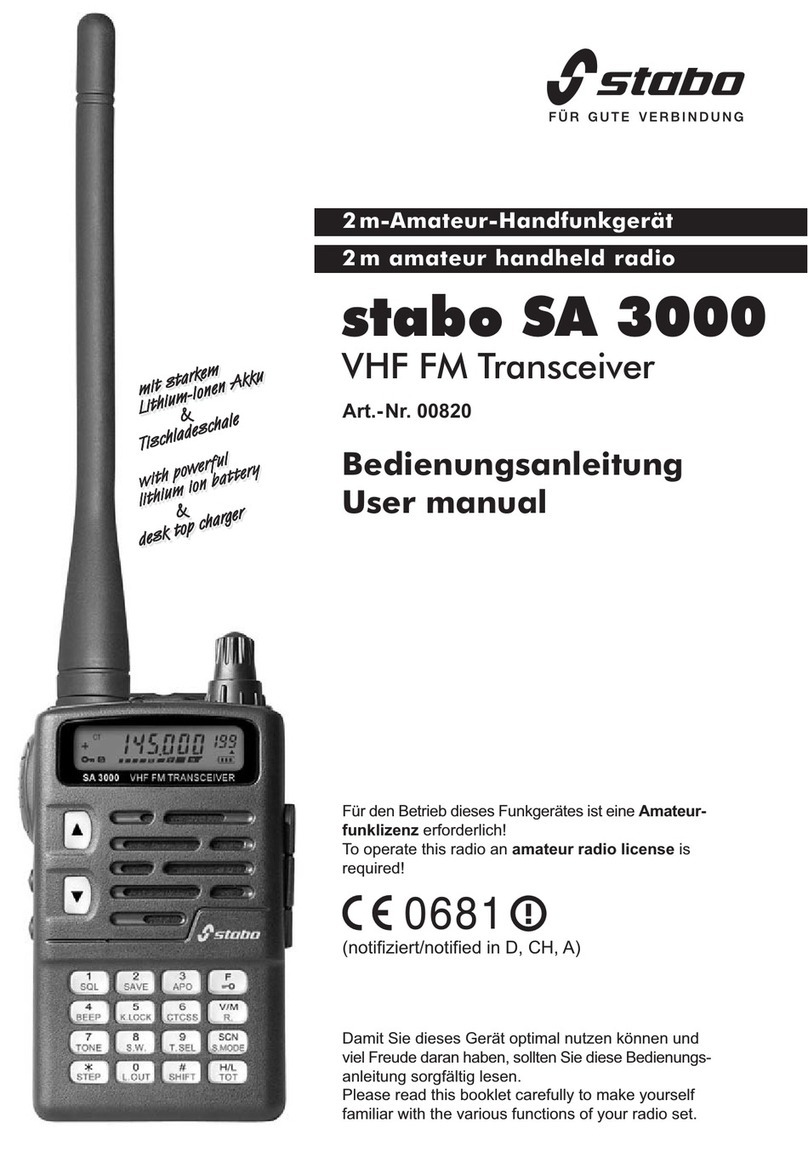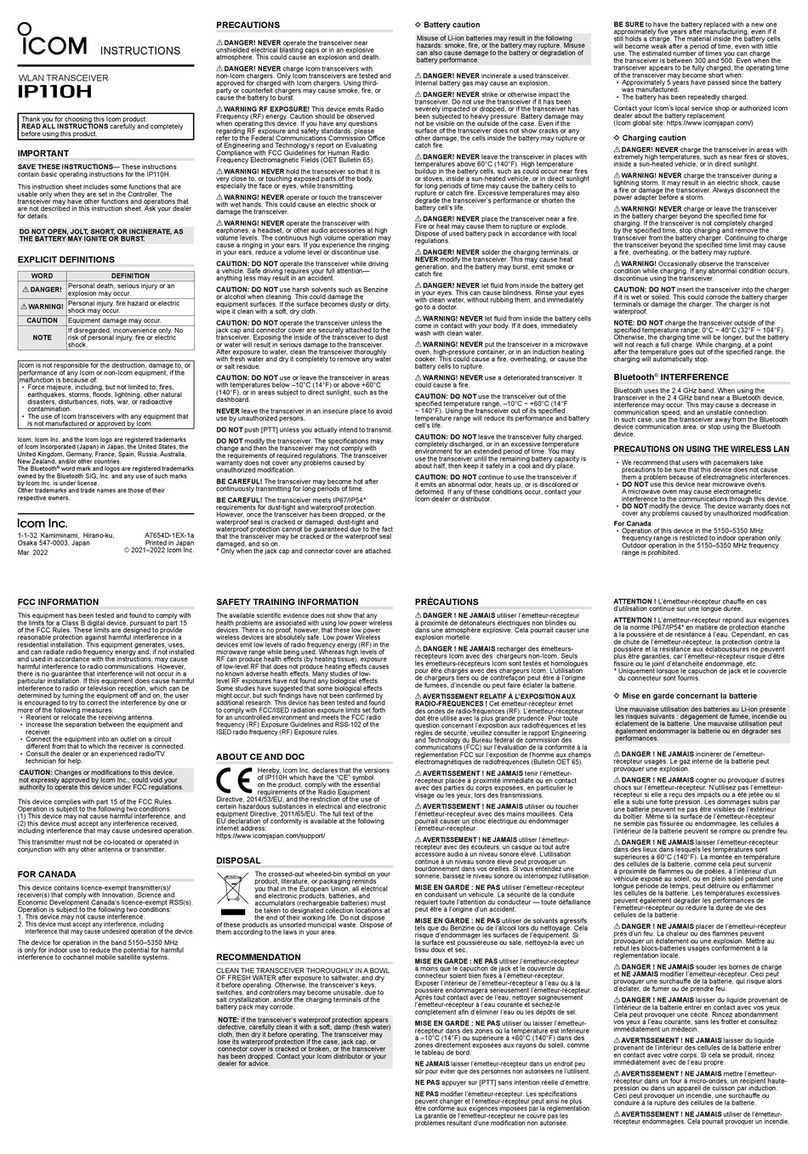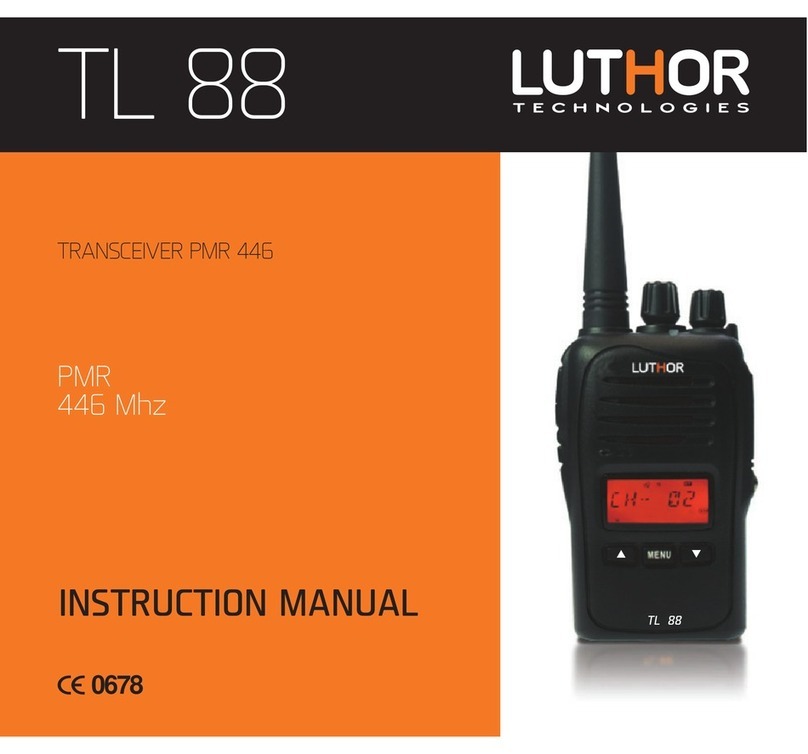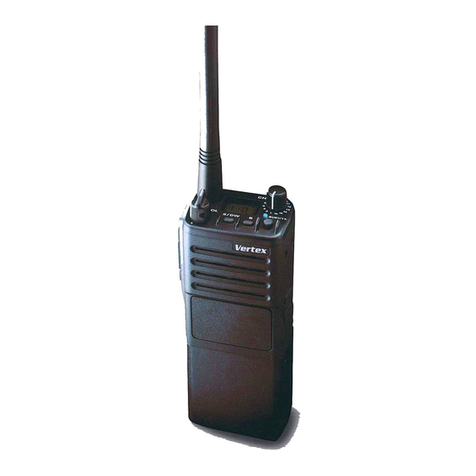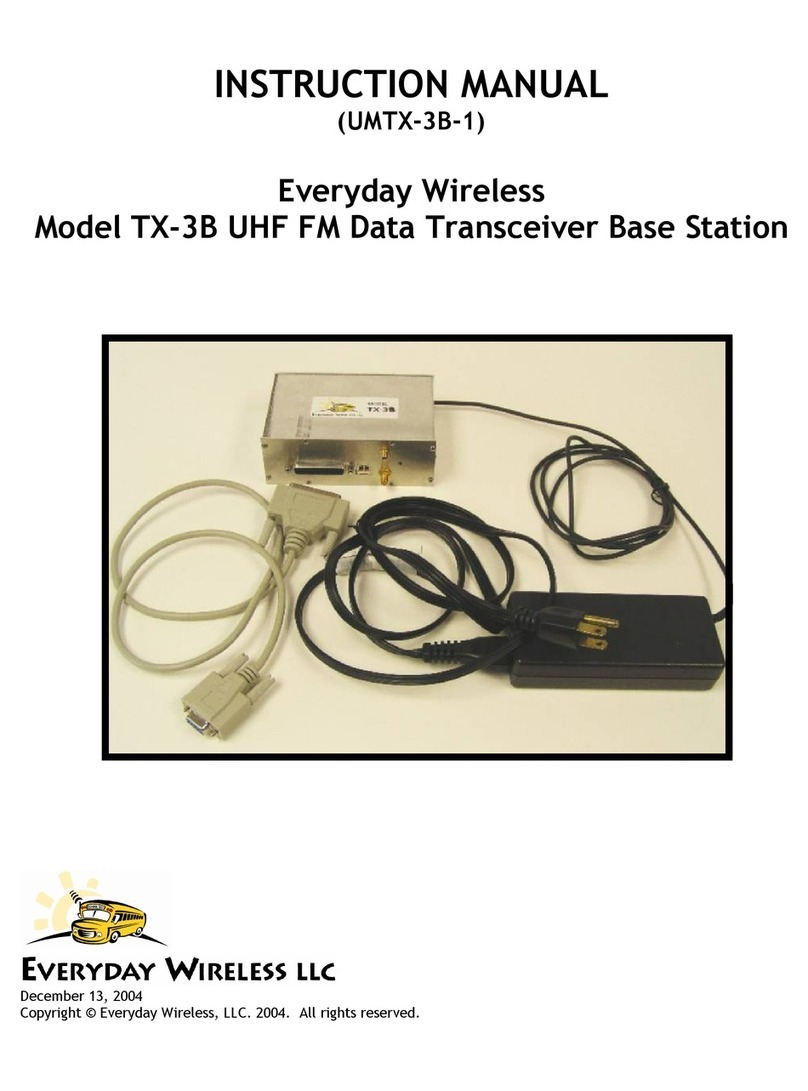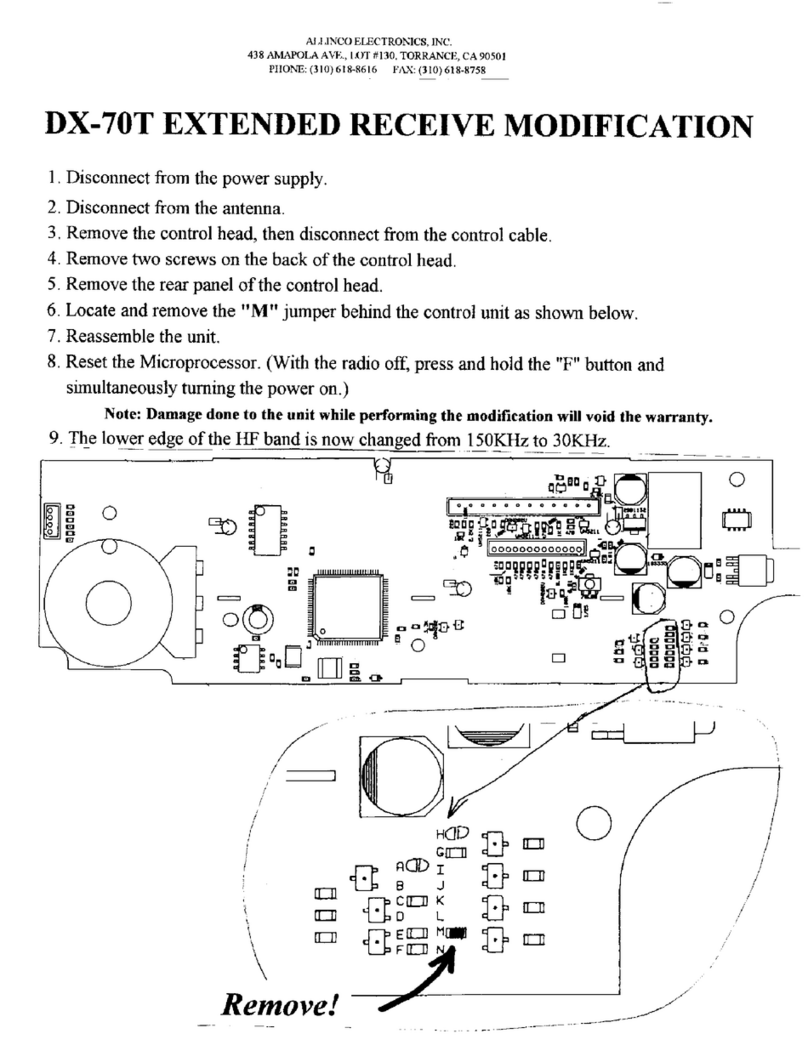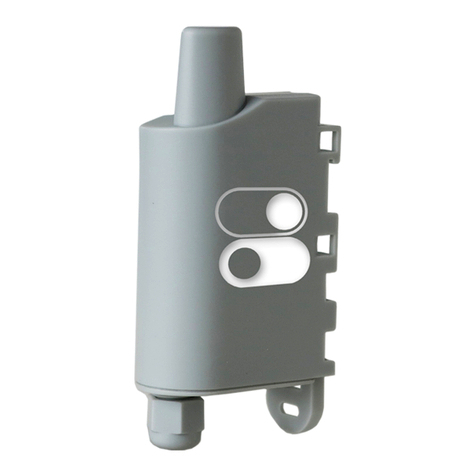TIL TDFM-7000 User manual

TDFM-7000
MULTIBAND P25 AIRBORNE TRANSCEIVER
(With Modification No. 3 Installed)
Installation and
Operating Instructions
TiL Document No. 05RE375
Rev. n/c Issue 13
AUGUST 2010
Technisonic Industries Limited
240 Traders Boulevard, Mississauga, Ontario L4Z 1W7
Tel: (905) 890-2113 Fax: (905) 890-5338
www.til.ca
Copyright by Technisonic Industries Limited. All rights reserved.

IMPORTANT
INFORMATION
As of January 1st, 2013, the FCC will no longer allow transceivers to be delivered
to the USA that are capable of wide band (25kHz) channel spacing in the
commercial 2 way mobile / base sections of the VHF and UHF bands. TDFM-7000
transceivers delivered to the USA after this date will no longer support wide band
operation on those bands. The 700 and 800 MHz bands are not affected.

i
REVISION HISTORY
[ 05RE375 ]
REV SECTION
- PAGE - DESCRIPTION DATE
EDITED
BY
n/c
issue 4 CR# 09501
Global Added Headers/Footers and Editing may have caused
pages to be added and re-sequenced as a result.
A Removed US address. Added NOTICE to the street
address and postal code change that may appear
different throughout this manual.
ii Table of Contents -added Fig 2.2 (missing)
3-6 Figure 3-2 contains typo
VHFHI (II) should read UHFHI (II) JAN 2009 FM
n/c
issue 5
CR# 09781
2-10 Tables 2.1 & 2.2 updated/changed
Revisions made to the tone/code tables (PL and DPL)
that are supported by the TDFM-7000
3-6,7 Fig 3.2 split in half and enlarged. JUN 2009 FM
n/c
issue 6 3-18,3-
19
added
Appendix is now section 3.18. 3.19 added for
Software Option to Control Latitude Satellite Gateway
S200–SG11
Section
2
Updated programming section and added TIBFM 12-
01 Rev E as Appendix A SEP 2009 FM
issue 7 2-6 Para 2.16 correct typo regarding appendix A
3-4 Para 3.10,3.11,3.12 correct typo correct TOC as well
3-7 Fig 3.2b correct typo c1-292 to c1-292-3,-4
Revision history sheet correct typo OCT 2009 FM
n/c
issue 8
iv
v
2-12
Back pg.
Added Edited by column in Revision History.
Motorola KVL 3000+® is a reg’d. trademark of
Motorola.
Table of Contents updated
Re-Sequenced paragraph 2.18&2.19 as 2.19 and
2.20
Added KEYLOADING MODE paragraph as 2.18
Added warranty to back page FEB 2010 FM
n/c
issue 9
Section
3
Added flight test option to glide slope test AUG 2010 SM
n/c
iss. 10
Section
1
Changed dimming voltages to include 28 VAC and 5
VDC.
OCT 2010 SM
Iss 11 -2- Correct typos (RF module frequencies) as found
3-1 Correct typo in para. 3.4 to kit (P/N 069662-1)
Para 3-5 added to CI-292 (-3 or -4), the “MALE” BNC
3-4 Para. 3.7 added “All harness connectors are Female.”
3-6,3-7 Update wiring diagram added SRA-6000 option
Changed item 2 to CI-292-3,-4, item 8 to 7.5A
Added notes 19-22 JAN 2012 FM

ii
REVISION HISTORY
[ 05RE375 ]
REV SECTION
- PAGE - DESCRIPTION DATE
EDITED
BY
Iss 12 2-15 Added Information about Auto Test feature with
Aeroflex 3920 Digital Test Set JUL 2012 JR
Iss 13 Jan 01, 2013 FCC narrowband notice added JAN 2013 SM

iii
NOTES
ESD CAUTION
This unit contains static sensitive devices. Wear a grounded wrist strap and/or conductive
gloves when handling printed circuit boards.
FCC COMPLIANCE INFORMATION
This device complies with Part 15 of the FCC Rules. Operation is subject to the following two
conditions: (1) this device may not cause harmful interference and (2) this device must accept any
interference received, including interference that may cause undesired operation.
WARNING: For compliance with FCC RF Exposure Requirements the mobile transmitter
antenna installation shall comply with the following two conditions:
1. The transmitter antenna gain shall not exceed 3 dBi.
2. The transmitter antenna is required to be located outside of a vehicle and kept at a separation distance
of 70 cm or more between the transmitter antenna of this device and persons during operation.
NOTE: This equipment has been tested and found to comply with the limits for a Class A digital
device, pursuant to Part 15 of the FCC Rules. These limits are designed to provide reasonable
protection against harmful interference when the equipment is operated in a commercial
environment. This equipment generates, uses, and can radiate radio frequency energy and, if not
installed and used in accordance with the instruction manual, may cause harmful interference to
radio communications. Operation of this equipment in a residential area is likely to cause harmful
interference, in which case the user will be required to correct the interference at his/her own
expense.
WARNING AND DISCLAIMER
Changes or modifications not expressly approved by Technisonic Industries could void the user’s
authority to operate the equipment.
This manual is designed to provide information about the TDFM-7000. Every effort has been made
to make this manual as complete and accurate as possible.
WARRANTY INFORMATION
The Model TDFM-7000 Transceiver is under warranty for one year from date of purchase. Failed
units caused by defective parts, or workmanship should be returned to:
Technisonic Industries Limited
240 Traders Boulevard
Mississauga, Ontario L4Z 1W7
Tel: (905) 890-2113
Fax: (905) 890-5338

iv
SUMMARY OF DO-160C ENVIRONMENTAL TESTING
Summary of DO-160C Environmental Testing for Technisonic Model TDFM-7000 Transceiver:
Conditions Section Description of Conducted Tests
Temperature and Altitude 4.0 Equipment tested to categories C4 and D1.
Vibration 8.0
Equipment is tested without shock mounts to
categories B, M and N.
Magnetic Effect 15.0 Equipment is class Z.
Power Input 16.0 Equipment tested to category B.
Voltage Spike 17.0 Equipment tested to category B.
RF Emission 21.0 Equipment tested to category Z.
INSTALLATION APPROVAL NOTE
Presently, no TSO standard exists for airborne FM transceivers. To make it easier for installation
agencies to provide their customers with an approved installation supported by an effective
Airworthiness Approval, Technisonic has secured Supplemental Type Certificate (STC) Approvals
(both US and Canadian) on its Airborne FM products for many helicopters currently being delivered
in the US and Canada as well as a number of single engine fixed wing aircraft. The above
referenced DO-160C test data is also on file and available from Technisonic to support approval
requirements in airframes for which Technisonic does not possess an STC.
Approved aircraft types are listed in the attachments to the formal STC documents. These STCs are
the exclusive property of Technisonic and require the written authority of Technisonic for their use.
To assist Factory Authorized Technisonic Dealers in the certification process, we have placed
copies of our Canadian and US STCs on our web site along with a letter of authorization for their
use. These documents may be downloaded and used as support for the technical submission to
FAA or Transport Canada. Only authorized factory dealers/installers are permitted to download and
make use of these documents on behalf of their customers (end users) in support of regulatory
agency approval. Please refer to the Technisonic web site www.til.ca for the latest issue of
available STCs and letter of authorization for use.
Trademark Notices
TDFM-7000 Transceivers contain two-way radio protocols licensed from Motorola, Inc.
© 1997, 1998 Motorola, Inc.
Motorola KVL 3000+® is a registered trademark of Motorola.

TECHNISONIC INDUSTRIES LIMITED
www.til.ca
TDFM-7000 Installation & Operating Instructions TiL 05RE375 Rev n/c Issue 13
v
TABLE OF CONTENTS
SECTION TITLE PAGE
SECTION 1 GENERAL DESCRIPTION
1.1 INTRODUCTION ................................................................................................ 1-1
1.2 DESCRIPTION ................................................................................................... 1-1
1.3 MODEL VARIATION ........................................................................................... 1-1
1.4 TECHNICAL CHARACTERISTICS ......................................................................... 1-3
SECTION 2 OPERATING INSTRUCTIONS
2.1 GENERAL ......................................................................................................... 2-1
2.2 FRONT PANEL .................................................................................................. 2-1
2.3 POWER SWITCH ............................................................................................... 2-2
2.4 KNOB .............................................................................................................. 2-2
2.5 SOFT KEYS AND HOME ..................................................................................... 2-2
2.6 BAND KEY ....................................................................................................... 2-3
2.7 FUNC KEY ........................................................................................................ 2-3
2.8 F1 – F4 KEYS ................................................................................................... 2-3
2.9 MUP(4) AND MDN(7) KEYS (Memory Up and Down Keys) ...................................... 2-5
2.10 UP(5) AND DN(8) KEYS ..................................................................................... 2-5
2.11 BRT(6) AND DIM(9) KEYS .................................................................................. 2-5
2.12 ESW(0) KEY (Ergo Switch) ................................................................................. 2-5
2.13 TSW (*) KEY .................................................................................................... 2-5
2.14 DISPLAY .......................................................................................................... 2-5
2.15 GENERAL OPERATION ....................................................................................... 2-6
2.16 CUSTOMER PROGRAMMING SOFTWARE (CPS™) .................................................. 2-6
2.17 CONFIGURATION MENU .................................................................................... 2-11
2.18 KEYLOADING MODE ......................................................................................... 2-12
2.19 FLASH UPGRADE MODE .................................................................................... 2-12
2.20 FRONT PANEL PROGRAMMING (FPP) MODE - OPTIONAL ...................................... 2-13
2.21 AUTOTEST CABABILITY .................................................................................... 2-15
SECTION 3 INSTALLATION INSTRUCTIONS
3.1 GENERAL ......................................................................................................... 3-1
3.2 EQUIPMENT PACKING LOG ................................................................................ 3-1
3.3 INSTALLATION ................................................................................................. 3-1
3.4 INSTALLATION KIT - CONTENTS ........................................................................ 3-1
3.5 ANTENNA INSTALLATION ................................................................................. 3-1
3.6 INSTALLATION - PIN LOCATIONS AND CONNECTIONS ......................................... 3-3
3.7 INSTALLATION - WIRING INSTRUCTIONS ............................................................ 3-4
3.8 MAIN GROUND – PINS 1 AND 14 ....................................................................... 3-4
3.9 MAIN POWER + 28VDC – PINS 2 AND 15 .......................................................... 3-4
3.10 MIC 1, 2, 3, 4 and COMBINED – J1 PINS 3, 6, 9 and J2 PIN 6; J2 PIN 7 (COMB) ..... 3-4
3.11 AUDIO 1, 2, 3, 4 and COMBINED – J1 PINS 4, 7, 10 and J2 PIN 5; J2 PIN 2 (COMB 3-4
3.12 PTT 1, 2, 3, 4 and COMBINED – J1 PINS 5, 8, 11 and J2 PINS 3; J2 PIN 4 (COMB) . 3-4
3.13 TX DATA AND RX DATA – J1 PINS 12 AND 13 ................................................... 3-4
3.14 CHANNEL UP AND CHANNEL DOWN – J1 PINS 16 AND 17 .................................. 3-4
3.15 LH DATA, SB9600 BUSY, OPTB+, CTS OUT, BOOT DIN, RTSBIN AND RS232DIN –
J1 PINS 18 THROUGH 24 ................................................................................... 3-4
3.16 PANEL BACKLIGHTING – J1 PIN 25 .................................................................... 3-5

TECHNISONIC INDUSTRIES LIMITED
www.til.ca
TDFM-7000 Installation & Operating Instructions TiL 05RE375 Rev n/c Issue 13
vi
SECTION TITLE PAGE
(Continued)
3.17 POWER JUMPER ............................................................................................... 3-5
3.18 POST INSTALLATION EMI TEST ......................................................................... 3-8
3.19 TDFM-7000/7300 SOFTWARE OPTION
FOR CONTROL OF LATITUDE SATELLITE GATEWAY S200-SG11 ............................ 3-19
3.19.1 GENERAL ................................................................................................... 3-19
3.19.2 INSTALLATION ........................................................................................... 3-19
3.19.3 OPERATING INSTRUCTIONS ......................................................................... 3-20
3.20 SATCOM MENUS ........................................................................................ 3-21
APPENDIX A Support Notes .......................................................................................... A-1
WARRANTY ................................................................................................................
LIST OF FIGURES
FIGURE TITLE PAGE
2.1 Front Panel Controls – TDFM-7000 Transceiver ..................................................... 2-1
2.2 PC 7000(II) Programming cable for TYPE II radios P/N 047365-1 ............................. 2-7
2.3 Encryption Keyload cable for TYPE I and TYPE II radios P/N 037348-1) .................... 2-7
2.4 TYPE I Programming cable P/N 037347-1 ............................................................. 2-9
2.5 Motorola RIB box for TYPE I Radios P/N RLN 1015D .............................................. 2-9
2.6 Type I (XTS-3000) Programming Cable (Requires RIB) ............................................ 2-10
2.7 USB to Serial Adaptor for Computers without Serial Ports ....................................... 2-11
3.1 Outline Drawing ................................................................................................ 3-2
3.2a Wiring Connections for the TDFM-7000 Transceiver .............................................. 3-6
3.2b Wiring Connections for the TDFM-7000 Transceiver .............................................. 3-7
3.3 TDFM-7000 and SG200-SG11 Wiring Diagram ...................................................... 3-19
LIST OF TABLES
TABLE TITLE PAGE
2.1 TDFM 7000 Series PL(Hz)/MOT Codes ................................................................. 2 14
2.2 TDFM 7000 Series DPL Codes ............................................................................ 2-14
3.1 25 Pin D Connections ........................................................................................ 3-3
3.2 9 Pin D Connections .......................................................................................... 3-3

TECHNISONIC INDUSTRIES LIMITED
www.til.ca
TDFM-7000 Installation & Operating Instructions TiL 05RE375 Rev n/c Issue 13
1-1
SECTION 1 - GENERAL DESCRIPTION
1.1 INTRODUCTION
This publication provides operating and installation information on the TDFM-7000 airborne
transceiver. The exact configuration depends on which and how many RF modules are
installed.
1.2 DESCRIPTION
The TDFM-7000 transceiver is an airborne multi-band radio capable of operation in
conventional analog and P25 digital FM systems, SmartNet/SmartZone trunking systems
and P25 9600 trunking systems. Type I RF modules are available in VHF, UHF-LO, UHF-HI
and 800 MHz bands. Type II RF modules support additional optional features not available in
type I modules and are currently available in VHF, UHF-LO, UHF-HI and 700/800 MHz.
These optional additional features include P25 9600 trunking that may be combined with
AES and/or DES-OFB encryption with OTAR in any of the available modules. The factory
will normally install only type II RF modules as the type I modules have limited availability.
However type I modules are fully supported and either some or all of the TDFM-7000’s RF
modules can be type I. If a unit is built with both types, two different programming
software packages will have to be purchased.
The TDFM-7000 is not normally frequency agile. In order to have the ability to change the
frequencies at the front panel, the FPP (front panel programming) option must be ordered
for each band. FPP is only available on the VHF and UHF modules. The FPP option precludes
trunking and limits available channels to 240 (15 zones/16 channels) on that module instead
of 1000 channels. Please note that all 240 memories must be filled if FPP is ordered.
1.3 MODEL VARIATION
There are several variations of the Model TDFM-7000 Transceiver. Each variation offers
different features and performance based on the type of RF modules and options installed.
Irrespective of module type the bands are numbered 1, 4, 5 and 8 for VHF, UHF low, UHF
Hi and 800/700 respectively. The transceivers part number indicates whether Type I (-1, -2)
or Type II (-3, -4) modules are installed along with which type of modules are installed.
The following part numbers represent typical TDFM-7000 model variations:
3 band TDFM-7000 Variations
P/N 051240-1-7188 One VHF and two 800 MHz, type I modules with Green display.
P/N 051240-3-7148 One VHF, UHF low and 800/700, type II modules with Green
display.
4 band TDFM-7000 Variations
P/N 051240-2-71558 One VHF, two UHF hi and one 800 MHz, type I modules with
Red display.
P/N 051240-1-71148 Two VHF, one UHF low and 800/700, type II modules with
Green display.
SmartNet and SMART ZONE are trademarks of Motorola, Inc.

TECHNISONIC INDUSTRIES LIMITED
www.til.ca
TDFM-7000 Installation & Operating Instructions TiL 05RE375 Rev n/c Issue 13
1-2
TDFM-7000 Model Variations with type I Modules
3 Band TDFM-7000 Model Variations (-7XXX)
TDFM-7000, P/N 051240-1-7XXX/P7YYY GREEN display.
TDFM-7000, P/N 051240-2-7XXX/P7YYY RED display.
TDFM-7000NV, P/N 051240-1-7XXXNV/P7YYY GREEN NV display.
4 Band TDFM-7000 Model Variations (-7XXXX)
TDFM-7000, P/N 051240-1-7XXXX/P7YYY GREEN display.
TDFM-7000, P/N 051240-2-7XXXX/P7YYY RED display.
TDFM-7000NV, P/N 051240-1-7XXXXNV/P7YYY GREEN NV display.
X is represented by:
1 for VHF (136-174MHz) module
4 for UHF Lo (403-470MHz) module
5 for UHF Hi (450-512MHz) module
8 for 800 MHz (806-870)
Module numbers must always be specified in
ascending order.
P7YYY represents a 4-digit project
number that identifies specific
options that are contained in the
module. The Technisonic sales
department assigns project
numbers based on customer
requirements. P7001 and up series
project numbers are used in
transceivers with type I modules.
TDFM-7000 Model Variations with type II Modules
3 Band TDFM-7000 Model Variations
TDFM-7000, P/N 051240-3-7XXX/P7YYY GREEN display.
TDFM-7000, P/N 051240-4-7XXX/P7YYY RED display.
TDFM-7000NV, P/N 051240-3-7XXXNV/P7YYY GREEN NV display.
4 Band TDFM-7000 Model Variations (-7XXXX)
TDFM-7000, P/N 051240-3-7XXXX/P7YYY GREEN display.
TDFM-7000, P/N 051240-4-7XXXX/P7YYY RED display.
TDFM-7000NV, P/N 051240-3-7XXXXNV/P7YYY GREEN NV display.
X is represented by:
1 for VHF (136-174MHz) module
4 for UHF Lo (380-470MHz) module
5 for UHF Hi (450-520 MHz) module
8 for 700/800 MHz (764-870)
Module numbers must always be specified in
ascending order.
P7YYY represents a 4-digit project
number that identifies specific
options that are contained in the
module. P7001 and up project
numbers are used in transceivers
with type II modules.
All model variations are capable of supporting both 28 Volt and 5 Volt AC or DC back
lighting. The units are shipped set to operate on 28 Volt back lighting. Equipment can be set
to operate on 5V back lighting by using the software based configuration menu. See
Section 2.17 configuration menu. (Damage will not occur if the incorrect voltage is applied.)

TECHNISONIC INDUSTRIES LIMITED
www.til.ca
TDFM-7000 Installation & Operating Instructions TiL 05RE375 Rev n/c Issue 13
1-3
1.4 TECHNICAL CHARACTERISTICS
Specification Characteristic
Model Designation: TDFM-7000
Physical Dimensions: Approx. (L) 8.0" x (W) 5.75" x (H) 3.75"
Weight: ~6.0 Lbs (2.7 Kg)
Operating Temperature Range: -30° C to +60° C
Power Requirement:
Voltage:
Current:
28.0 VDC ± 15%
500 mA minimum / 5A maximum
Audio Output Power (including sidetone): 600 mW into 600 Ω
Microphone Inputs: Carbon or Equivalent
Panel Back Lighting:
Voltage:
Current:
28 or 5 Volts AC or DC (selectable)
10 uA
Type I Modules
Specification Characteristic
RF Output Power: 1 or 5 Watts (VHF)
1 or 4 Watts (UHF)
1 or 3 Watts (800)
Frequency Range
VHF Module:
UHF LO Module:
UHF HI Module:
800 Module:
136 to 174 MHz
403 to 470 MHz
450 to 512 MHz
806 to 870 MHz
No. of channels per band: 255 pre-programmable channels
Transmitter section VHF UHF 800
FM Hum and noise in dB (wideband):
Frequency Stability in ppm:
Audio Distortion (at 1000Hz):
Modulation Limiting:
-48 -45 -45
±2.0 ±2.0 ±1.5
<2% <2% <2%
Wide band ±5kHz
Narrow band ±2.5kHz
Receiver section VHF UHF 800
Sensitivity in uV:
*Digital 1% BER (12.5kHz)
*Digital 5% BER (12.5kHz)
**Analog with 12dB SINAD
0.35 0.35 0.45
0.25 0.25 0.25
0.25 0.25 0.25
Selectivity in dB:
25 kHz Channel
12.5 kHz Channel
Intermodulation (dB) * **
-78 -78 -75
-67 -68 -63
-78 -77 -74

TECHNISONIC INDUSTRIES LIMITED
www.til.ca
TDFM-7000 Installation & Operating Instructions TiL 05RE375 Rev n/c Issue 13
1-4
1.4 TECHNICAL CHARACTERISTICS (continued)
Type II Modules
Specification Characteristic
RF Output Power: 1 or 6 Watts (VHF)
1 or 5 Watts (UHF)
1 or 3 Watts (800)
Frequency Range
VHF Module:
UHF LO Module:
UHF HI Module:
700 / 800 Module:
136 to 174 MHz
380 to 470 MHz
450 to 520 MHz
764 to 870 MHz
No. of channels per band: 1000 pre-programmable channels
850 for older radios
240 channels (15 zones of 16 channels) in
modules with Front Panel Programming.
Transmitter section VHF UHF 800
FM Hum and noise in dB (wideband):
Audio Distortion:
Frequency Stability in ppm:
Modulation Limiting:
-48 -45 -45
1% 1.5% 1.5%
±2.0 ±2.0 ±1.5
Wide band ±5kHz
Narrow band ±2.5kHz
Receiver section VHF UHF 800
Sensitivity in uV:
*Digital 1% BER (12.5kHz)
*Digital 5% BER (12.5kHz)
**Analog with 12dB SINAD
0.25 0.25 0.40
0.25 0.25 0.25
0.25 0.25 0.25
Selectivity in dB:
25 kHz Channel
12.5 kHz Channel
Intermodulation * **
-80 -78 -72
-63 -63 -63
-78 -77 -75
*Measured in digital mode per TIA / EIA IS 102.CAAA under nominal conditions.
** Measured in analog mode per TIA / EIA 603 under nominal conditions.

TECHNISONIC INDUSTRIES LIMITED
www.til.ca
TDFM-7000 Installation & Operating Instructions TiL 05RE375 Rev n/c Issue 13
2-1
SECTION 2 – OPERATING INSTRUCTIONS
2.1 GENERAL
A 5-line display and a keypad and a rotary knob provide the operator control of up to 4 RF
modules installed in the unit. The display is showing the activity of all 4 modules (bands) as
well as the menu of the active band, selected by pressing the BAND key. The knob has
multiple functions including volume, and channel. The microphone, key line and headphone
audio can be wired separately for each of the 4 bands therefore switching from band to
band is performed at an audio panel such as the Technisonic A71X series. This allows for
separate and simultaneous operation on each of the bands just like having 4 separate
radios. The transceiver can also be connected so that all bands are available on the
combined output. In this configuration, the BAND key on the transceiver must perform
switching between bands and the user can only transmit on one band at a time. It is
possible to connect the transceiver such that both methods are used.
2.2 FRONT PANEL
Refer to the diagrams below:
FIGURE 2.1 Front Panel Controls – TDFM-7000 Transceiver

TECHNISONIC INDUSTRIES LIMITED
www.til.ca
TDFM-7000 Installation & Operating Instructions TiL 05RE375 Rev n/c Issue 13
2-2
2.3 POWER SWITCH
To switch the transceiver on, press and hold the knob until the radio powers up. The display
will show TECHNISONIC and the software version installed followed by the model number
along with which RF modules are installed. The display will then show the normal display.
To switch off the transceiver at any time, press and hold the knob for 2 seconds until the
display shows OFF then release. If it is desired that the radio turns on with the radio master
in the aircraft, a power jumper may be installed (see installation instructions) such that the
radio is always on. The battery master must be used to turn the radio off with this jumper
installed.
2.4 KNOB
The knob is a rotary encoder, which turns endlessly, meaning its actual position is not
important. The knob also has a push button incorporated in it so you can press the knob as
well as turn it. The knob will start out as a volume control. Pressing the knob again will
change its function to act as the channel selector. Pressing the knob again causes the
keypad function to change from function keys to number keys. In Vol mode the knob acts
as a volume control. Several knob presses will bring you to the recall mode. In the recall
mode, typing in the channel number will bring you quickly to that channel without scrolling
through channels in between. Pressing the knob again brings it back to the volume control
mode. The current function of the knob is shown at the bottom right of the display.
2.5 SOFT KEYS AND HOME
The transceiver has three soft keys, which assume the function shown on the menu above
them on the display. The functions displayed depend on how the selected module was
programmed with the customer programming software (CPS)™. These menu items can be
different on a channel by channel basis. Typical menu items may include:
ZONE - Pressing this function will prompt you for a new zone number which can be
entered directly (if the keypad is in numlock mode) or scrolled using the UP and
DN keys.
MUTE - Selecting this function will prompt you for an on or off entry using the soft keys
to mute the tones. Tones refer to the beeps heard when pressing buttons.
VIEW - The view function is used to view lists. Lists can include scan lists, phone
numbers, call lists and or paging.
PWR - Selecting PWR will allow the power output of the radio to be set to high or low.
PROG - Selecting PROG allows brings you to user programmable features of the radio
such as telephone numbers or scan lists. The ability for the user to program
phone numbers, scan lists, etc can be enabled or disabled by the CPS™.
FPP - Front Panel Programming mode allows you to program at the front panel
without the customer programming software. This option is available on VHF
and UHF type II modules only.
At any time while in one of these functions, you can escape back to the normal mode by
pressing the HOME key. When programming the modules with the CPS™, it is suggested not
to double up functions. For example, programming a soft key to CHAN would be redundant
since there is already a channel function using the knobs. Using the CHAN soft key would
also not update the channel number on the display, causing some confusion.

TECHNISONIC INDUSTRIES LIMITED
www.til.ca
TDFM-7000 Installation & Operating Instructions TiL 05RE375 Rev n/c Issue 13
2-3
2.6 BAND KEY
Pressing the BAND key will select the next band in sequence. A solid arrow will indicate
which band is selected. If the TDFM-7000 audio routing (see the configuration menu) is set
up in single mode, the band key also acts as the transmit select.
2.7 FUNC KEY
Pressing the FUNC key will bring up the first functions menu:
F1–F4 = Channels - Pressing one of these keys will load a pre-programmed
channel.
4 = Record - Pressing 4 will cause the transceiver to record the next message
received on the band selected.
5 = Playback - Pressing 5 will play the last message recorded.
Pressing the FUNC key again will bring up the second menu. The following functions are
available:
1 = Crossband Repeat - You can select any two bands to cross band repeat. The
repeat function is semi-duplex. This means the TDFM-7000 will retransmit from one
band to another in both directions but not simultaneously.
2 = Configuration - Enters the configuration menu (see 2.18 configuration menu).
This is the same menu that can be invoked during boot up.
3 = Simulcast - You can select bands to transmit simultaneously. Simulcast is not
available when audio routing is set to separate mode and will not show up in the
functions menu.
4 = F1-F4 Programming - Allows you to program a channel and zone to the F1 to
F4 keys.
5 = Simplex Repeat - When turned on, the band selected will become a simplex
repeater. Simplex repeat (sometimes called parrot repeat) will record an incoming
message and immediately retransmit the message on the same frequency.
2.8 F1-F4 KEYS
Four function keys at the top of the keypad provide the same actions as the three side
buttons and the top button found on the XTS-3000 or XTS-5000 portable. They are as
follows:
F1 - Upper side button (purple button) on the portable.
F2 - Middle side button (with one dot) on the portable.
F3 - Bottom side button (with two dots) on the portable.
F4 - Top button (orange button) on the portable.

TECHNISONIC INDUSTRIES LIMITED
www.til.ca
TDFM-7000 Installation & Operating Instructions TiL 05RE375 Rev n/c Issue 13
2-4
TDFM-7000 Transceiver Recommended Keypad Menu Defaults:
TDFM-7000
Series Transceiver
ITEM
Portable
ITEM
Conventional
Operation
SmartNet
Operation
SmartZone
Operation
F1 Key Upper Side
Button 1
Monitor Unprogrammed Unprogrammed
F2 Key Middle Side
Button 2
Nuisance Delete Nuisance Delete Nuisance Delete
F3 Key Bottom Side
Button 3
Talkaround/
Direct
Unprogrammed Unprogrammed
F4 Key Top Button Volume Set Tone Volume Set Tone Volume Set Tone
MUP and
MDN keys
16-Position
Rotary Knob
Channel Select Channel Select Channel Select
ESW Key Two-Position
Concentric or
Ergo Switch
Unprogrammed
A (∅)
Unprogrammed
B (O)
Unprogrammed
A (∅)
Unprogrammed
B (O)
Unprogrammed
A (∅)
Unprogrammed
B (O)
TSW Key Three-Position
Toggle Switch
Blank (A)
PL Disable (B)
Scan (C)
Blank (A)
PL Disable (B)
Scan (C)
Blank (A)
PL Disable (B)
Scan (C)
NOTE: It is possible to use Motorola’s Customer Programming Software (CPS™) to alter the default
keypad settings of the TDFM-7000 radio. However if custom key settings are chosen it will
not be possible for Technisonic to help the Pilot or other Radio User through operational
difficulties. These questions will have to be referred to the Radio System Administrator
responsible for customising the settings. Technisonic recommends that the default key
settings stay in place until all airframe installation and operational issues have been overcome.
The TDFM-7000 Transceiver is programmable by Motorola CPS™. The following settings
may be programmed for each Channel in a Conventional Radio:
Tx Frequency Zone
Tx PL/DPL Code Channel
Rx Frequency Name
Rx PL/DPL Code RX Signal Voice Type
Time-Out Timer TX Signal Voice Type
Scan List Network Access Code
Phone Tx Power
Smart PTT
The following settings must be programmed for each mode in a Trunked (P25 9600,
SmartNet or SmartZone) Radio:
System Type TG Strapping
System ID Zone
Individual ID Scan List
Coverage Type Scan Type
Affiliation Type Interconnect
Control Channel 1 Phone Display Format
Control Channel 2 Private Call
Talkgroup 1 Private Call Type
Talkgroup 2 Private Call Operation

TECHNISONIC INDUSTRIES LIMITED
www.til.ca
TDFM-7000 Installation & Operating Instructions TiL 05RE375 Rev n/c Issue 13
2-5
The function keys along with the rest of the keypad, revert to normal number keys during
transmit and when NUM LOCK is selected by pressing the rotary knob.
The F1 – F4 keys can be programmed as quick channel keys as mentioned in 2.7.
Depending on the setting in the configuration menu, the keys can be permanently set to
channels or used for other functions (normal). When the F1 –F4 keys are in the normal
mode they can still be used for quick channels if the FUNC key is pressed first.
2.9 MUP(4) AND MDN(7) KEYS (Memory Up and Down Keys)
These keys provide the same function as the rotary knob does when it is set to CHAN. This
equates to the 16 position rotary knob on the portable. When one of these keys is pressed,
the function of the rotary knob is automatically set to CHAN.
2.10 UP(5) AND DN(8) KEYS
The keys provide the same function as the left and right arrow keys on the portable. The UP
key equates to the right arrow key. These keys are used for a variety of functions but in the
normal mode they are used to scroll through the soft key menus.
2.11 BRT(6) AND DIM(9) KEYS
Use these keys to dim or brighten the display. The radio powers up at full brightness for
normal use but can be dimmed for night operations.
2.12 ESW(0) KEY (Ergo Switch Key)
The ESW key provides the function of the concentric or ‘ergo’ switch on the portable. The
switch has two conditions which are represented by ‘O’ and ‘∅’. Pressing the ESW key
toggles the condition back and forth. The condition is displayed at the right hand side of the
display line, second character from the right. The ergo switch condition is saved when the
unit is turned off. There are separate conditions for each band installed. The ESW key can
be programmed with the CPS™ to a variety of functions such as low power, scan and
secure or encrypted mode.
2.13 TSW (*) KEY (Toggle Switch Key)
The TSW key provides the function of the toggle switch on the portable. The switch has
three conditions which are represented by ‘A’, ‘B’ and ‘C’. Pressing the TSW key toggles
the condition A,B,C,A,B, etc. The condition is displayed at the right hand side of the display
line, last character on the right. The toggle switch condition is saved when the unit is turned
off. There are separate conditions for each band installed. The TSW key can be programmed
with the CPS™ to a variety of functions such as low power, scan, zone select, or pl disabled
mode.
2.14 DISPLAY
The transceiver has a 5-line, 120-character LED display. The top 4 lines display the zone
name, channel name, condition symbols (scan, direct, call, secure, monitor, etc) and switch
settings for each band. An LED on the left side of each band indicates a receive condition
while an LED on the right side of each line indicates transmit. A solid arrow on the first
character indicates which band is selected. The fifth line displays the menu items associated
with the band selected and the mode the knob is in.

TECHNISONIC INDUSTRIES LIMITED
www.til.ca
TDFM-7000 Installation & Operating Instructions TiL 05RE375 Rev n/c Issue 13
2-6
2.15 GENERAL OPERATION
Switch on the transceiver as described in 2.3. Select the desired band by pressing the
BAND key. Select the TDFM-7000 on the aircraft audio panel. Press the knob again so that
CHAN shows up on the top right of the display. Rotate the knob until the desired channel or
talk group is selected. Press the knob until VOL is again shown on the display. You can
adjust the volume by waiting until a signal is received or by pressing F1 (factory
programmed for monitor function) and adjusting the rotary knob. The radio is ready to use.
If the radio is installed in separate mode, remember that the band selected by pressing the
BAND key is what menu is displayed on the screen but the band selected by the audio panel
is band that you are actually transmitting and receiving on. To use the DTMF keypad while
transmitting, the band you are using must be selected on the display.
2.16 CUSTOMER PROGRAMMING SOFTWARE (CPS™)
Programming the TDFM 7000 is usually done with the use of third party programming
software. Customer programming software or “CPS” must be supplied by Motorola.
There are 2 different software packages that can be used to program the TDFM 7000. The
software package required depends what type of modules are installed. Most TDFM 7000
radios are built with TYPE II modules. These radios can be identified by the P/N 051240-[3]
or –[4]. For TDFM 7000s built with TYPE I modules (P/N 051240-[1] or –[2]) see the
section on TYPE I programming.
To make any changes to the programming in the Type II radio, Motorola CPS™ software
must be used. There is no provision in the TYPE II radio to allow the user to change
frequencies, zones, PL tones etc. unless the Front Panel Programming (FPP) option has been
purchased in each band. CPS™ software must be purchased from Motorola directly.
A Programming cable is required to connect the computer to the TDFM-7000 if type II
modules are installed. Each band in the TDFM-7000 is considered a type II (XTS-5000)
portable by the CPS™ software. To program a band in the transceiver, it must be selected
by pressing the BAND key before running the CPS™. Follow the instructions supplied with
the CPS™.
The CPS Programming software must be purchased from Motorola On Line (MOL).
For instructions on ordering Motorola parts and CPS software see TIB TIBFM 12-01 REV E.
This document is available from App xx or on the Technisonic Web site at www.til.ca.
Follow the link for TDFM 7000 and click in the Link for “CPS Programming software/Cables
ordering Guide”. Refer to the section for TYPE II modules.
Programming cables for units with Type II modules
The TDFM-7000 transceiver that employs type II modules does not require a Smart RIB box,
AC power pack or computer RIB cable. A Technisonic programming cable, and Motorola
“ASTRO 25 Portable CPS” Programming software, P/N RVN4181 (Latest revision) is all that
is required to program transceivers with type II modules.
If encryption keys need to be loaded via a KVL-3000+, keyloader cable P/N 037348-1 may
be also be obtained from Technisonic. This keyloader cable will plug into the front mini DIN
connector of the TDFM-7000 transceiver and work with type I or type II modules.

TECHNISONIC INDUSTRIES LIMITED
www.til.ca
TDFM-7000 Installation & Operating Instructions TiL 05RE375 Rev n/c Issue 13
2-7
The following cables can be purchased from Technisonic:
P/N 047365-1 TYPE II Download/Programming Cable that mates the 7000 front panel
8-pin mini DIN to PC computer 9 pin serial port.
P/N 037348-1 Encryption Keyload Cable that mates the 7000 front panel 8-pin Mini DIN
with Motorola KVL-3000+ Keyloader. Same P/N for type I or type II
modules.
FIGURE 2.2 PC 7000(II) Programming cable for TYPE II radios P/N 047365-1
FIGURE 2.3 Encryption Keyload cable for TYPE I and TYPE II radios P/N 037348-1

TECHNISONIC INDUSTRIES LIMITED
www.til.ca
TDFM-7000 Installation & Operating Instructions TiL 05RE375 Rev n/c Issue 13
2-8
Programming Cables for units with Type I modules
To make any changes to the programming in the radio, CPS™ software must be used. There
is no provision in the Type I radio to allow the user to change frequencies, zones, talk
groups, etc. from the front panel.
“ASTRO Saber & XTS 3000”CPS™ software can be purchased from Motorola Customer
Service (see following page). A Motorola Radio Interface Box (RIB) is required to connect
the computer to the TDFM-7000 if Type I modules are installed. Each band in the TDFM-
7000 is considered a Type I (XTS-3000) portable by the CPS™ software. To program a band
in the transceiver, it must be selected by pressing the BAND key before running the CPS™.
Follow the instructions supplied with the CPS™ and RIB. The radio cable supplied with the
RIB will not connect to the TDFM-7000, therefore you will need to purchase the Type I
programming cable, P/N 037347-1.
The CPS Programming software must be purchased from Motorola on Line (MOL).
For instructions on ordering Motorola parts and CPS software see TIB TIBFM 12-01 REV E.
This document can be found in Appendix A or is available on the Technisonic Web site at
www.til.ca.
Follow the link for TDFM 7000 and click in the Link for “CPS Programming software/Cables
ordering Guide”. Refer to the section for Type I Modules.
P/N RVN4182 CPS Programming Software,
Note: Latest revision will be provided.
P/N RLN10150 Smart RIB Interface Box
P/N 0180202E27 Smart RIB AC PWR PAC 110V
P/N 3080390B48 Computer RIB Cable
The XTS-3000 and XTS-5000 are products of Motorola, Inc.
The KVL-3000 is a product of Motorola, Inc.
A Technisonic Type I programming cable P/N037347-1 is also required and available from
Technisonic. If encryption keys need to be loaded via a KVL-3000+, keyloader cable P/N
037348-1 may be also be obtained from Technisonic. This keyloader cable will plug into the
front connector of the TDFM-7000 transceiver and will work with Type I or Type II modules.
To use the programming connector on the front of the TDFM-7000 transceiver, which is
preferable when the unit is installed in an aircraft, use the following:
P/N 037347-1 Download/Programming Cable that mates with RIB interface Box to
program TDFM-7000 units employing Type I modules.
P/N 037348-1 Encryption Keyload Cable that mates with Motorola KVL-3000
Keyloader. Same P/N for Type I or Type II modules.
P/N 013524-1 Alternate programming cable that mates with Rear DB 25 connector.
Table of contents
Other TIL Transceiver manuals
